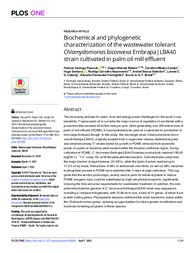Biochemical and phylogenetic characterization of the wastewater tolerant Chlamydomonas biconvexa Embrapa|LBA40 strain cultivated in palm oil mill effluent.
Biochemical and phylogenetic characterization of the wastewater tolerant Chlamydomonas biconvexa Embrapa|LBA40 strain cultivated in palm oil mill effluent.
Autoria: PASCOAL, P. V.; RIBEIRO, D. M.; CEREIJO, C. R.; SANTANA, H.; NASCIMENTO, R. C.; STEINDORF, A. S.; GARCIA, L. C.; FORMIGHIERI, E. F.; BRASIL, B. dos S. A. F.
Resumo: The increasing demand for water, food and energy poses challenges for the world´s sustainability. Tropical palm oil is currently the major source of vegetable oil worldwide with a production that exceeds 55 million tons per year, while generating over 200 million tons of palm oil mill effluent (POME). It could potentially be used as a substrate for production of microalgal biomass though. In this study, the microalgal strain Chlamydomonas biconvexa Embrapa|LBA40, originally isolated from a sugarcane vinasse stabilization pond, was selected among 17 strains tested for growth in POME retrieved from anaerobic ponds of a palm oil industrial plant located within the Amazon rainforest region. During cultivation in POME, C. biconvexa Embrapa|LBA40 biomass productivity reached 190.60 mgDW ? L-1 ? d-1 using 15L airlift flat plate photobioreactors. Carbohydrates comprised the major fraction of algal biomass (31.96%), while the lipidic fraction reached up to 11.3% of dry mass. Reductions of 99% in ammonium and nitrite, as well as 98% reduction in phosphate present in POME were detected after 5 days of algal cultivation. This suggests that the aerobic pond stage, usually used in palm oil industrial plants to reduce POME inorganic load, could be substituted by high rate photobioreactors, significantly reducing the time and area requirements for wastewater treatment. In addition, the complete mitochondrial genome of C. biconvexa Embrapa|LBA40 strain was sequenced, revealing a compact mitogenome, with 15.98 kb in size, a total of 14 genes, of which 9 are protein coding genes. Phylogenetic analysis confirmed the strain taxonomic status within the Chlamydomonas genus, opening up opportunities for future genetic modification and molecular breeding programs in these species.
Ano de publicação: 2021
Tipo de publicação: Artigo de periódico
Unidade: Embrapa Agroenergia
Palavras-chave: Biomassa, Chlamydomonas biconvexa Embrapa|LBA40, Microbial biomass, Microbial genetics, Palm oils, Wastewater
Observações
1 - Por padrão são exibidas publicações dos últimos 20 anos. Para encontrar publicações mais antigas, configure o filtro ano de publicação, colocando o ano a partir do qual você deseja encontrar publicações. O filtro está na coluna da esquerda na busca acima.
2 - Para ler algumas publicações da Embrapa (apenas as que estão em formato ePub), é necessário ter, no celular ou computador, um desses softwares gratuitos. Sistemas Android: Google Play Livros; IOS: iBooks; Windows e Linux: software Calibre.
Acesse outras publicações
Acesse a Base de Dados da Pesquisa Agropecuária (BDPA) para consultar o acervo completo das bibliotecas da Embrapa.

